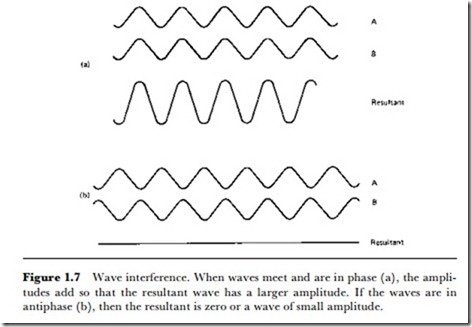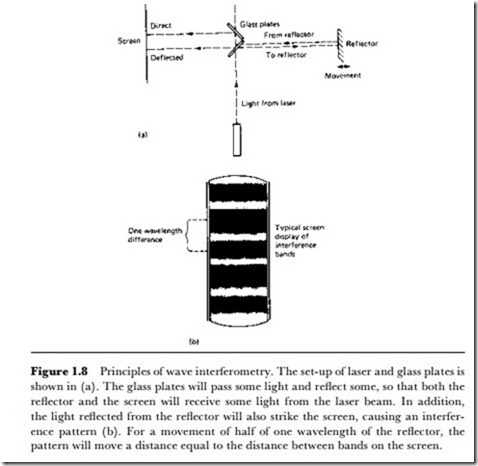Interferometry
Laser interferometry is another method of strain measurement that presents considerable advantages, not least in sensitivity. Though the principles of the method are quite ancient, its practical use had to wait until suitable lasers and associated equipment had been developed, along with practicable electronic methods of reading the results. Before we can look at
what is involved in a laser interferometer strain gauge, we need to under- stand the basis of wave interference and why it is so difficult to achieve with light.
All waves exhibit interference (Figure 1.7). V\hen two waves meet and are in phase (peaks of the same sign coinciding), then the result is a wave of greater amplitude, a reinforced wave. This is called constructive interference. If the waves are in opposite phase when they meet, then the sum of the two waves is zero, or a very small amplitude of wave, and this is destructive interference. The change from constructive to destructive interference therefore occurs for a change of phase of one wave relative to another of half a cycle. If the waves are emitted from two sources, then a movement of one source by a distance equal to half a wavelength will be enough to change the interference from constructive to destructive or vice versa. If the waves that are used have a short wavelength, then the distance of half a wavelength can be very short, making this an extremely sensitive measurement of change of distance.
The wavelength of red light is about 700 nm, i.e., 10-7 m or 10-4 mm, so that a shift of half this distance between two red light sources could be expected to cause the change between fully constructive and fully destructive interference – in practice we could detect a considerably smaller change than this maximum amount.
This method would have been used much earlier if it were not for the problem of coherence. Interference is possible only if the waves that are interfering are continuous over a sufficiently long period. Conventional
light generators, however, do not emit waves continuously. In a light source such as a filament bulb or a fluorescent tube, each atom emits a pulse of light radiation, losing energy in the process, and then stops emitting until it has regained energy. The light is therefore the sum of all the pulses from the individual atoms, rather than a continuous wave. This makes it impossible to obtain any interference effects between two separate normal sources of light, and the only way that light interference can normally be demonstrated using such sources is by using light that has passed through a pinhole to interfere with its own reflection, with a very small light path difference.
The laser has completely changed all this. The laser gives a beam in
which all the atoms that contribute light are oscillating in synchronization; this type of light beam is called coherent. Coherent light can exhibit interference effects very easily, and has a further advantage of being very easy to obtain in accurately parallel beams from a laser. The interferometer makes use of both of these properties as illustrated in Figure 1.S.
Light from a small laser is passed to a set of semi-reflecting glass plates and some of the light is reflected onto a screen. The rest of the light is aimed at a reflector, so that the reflected beam will return to the glass plates and also be reflected to the screen. Now this creates an interference pattern between the light that has been reflected from the outward beam and the light that has been reflected from the returning beam. If the distant reflector moves by one quarter of a wavelength of light, the light path of the beam to and from the reflector will change by half a wavelength, and the interference will change between constructive and destructive. Since this is a light beam, this implies that the illumination on the screen will change between bright and dark. A photocell can measure this change, and by connecting the photocell through an amplifier to a digital counter, the number of quarter wavelengths of movement of the distant reflector can be measured electronically.
The interferometer is often much too sensitive for many purposes. For example, the effect of changing temperatures is not easy to compensate for, though this can be done by using elaborate light paths in which the two interfering beams have travelled equal distances, one in line with the stress and the other in a path at right angles. An advantage of this method is that no physical connection is made between the points whose distance is being measured; there is no wire or semiconductor strip joining the points; the main body of the interferometer is in one place and the reflector in another. The distance between the main part of the device and the reflector is not fixed, the only restraint being that the distance must not exceed the coherence distance for the laser. This is the average distance over which the light remains coherent, and is usually at least several metres for a laser source.

